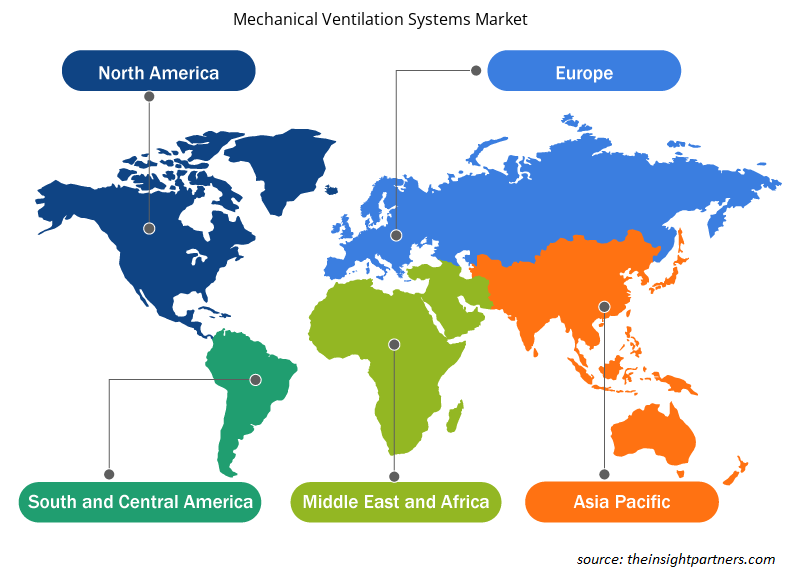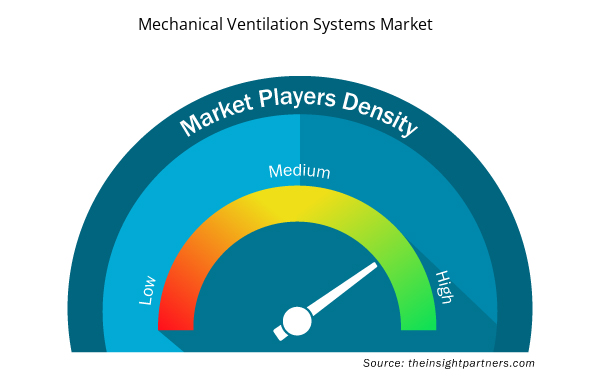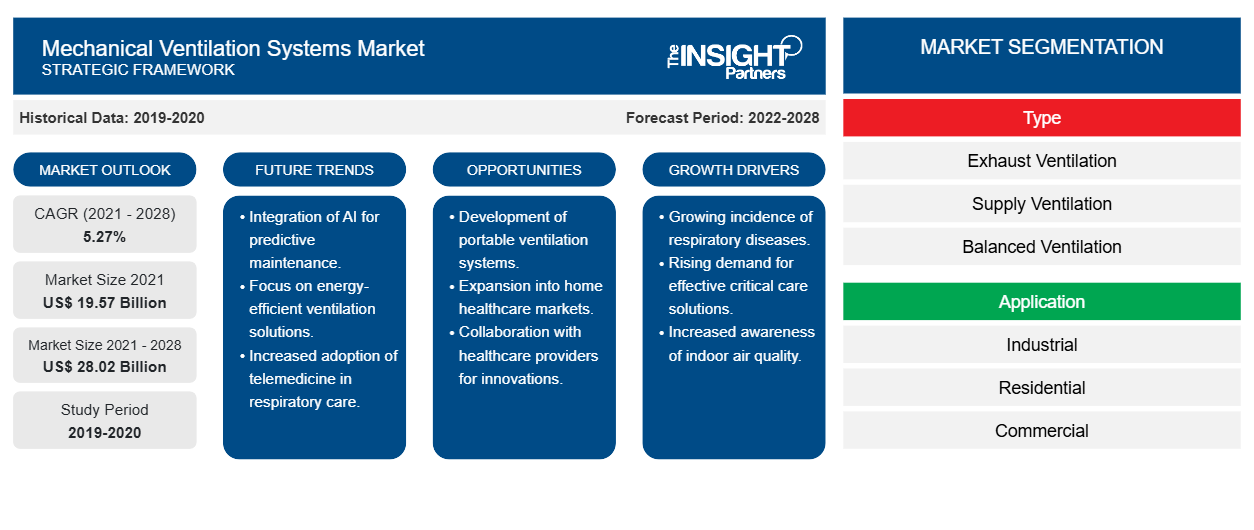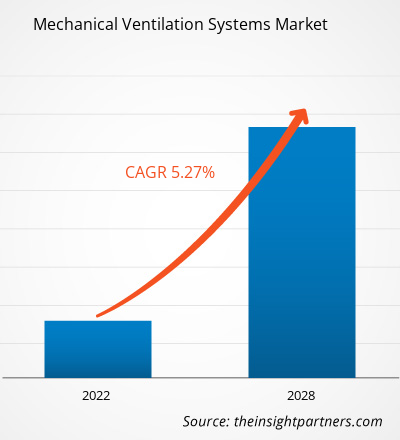机械通风系统市场预计将从 2021 年的 195.6667 亿美元增长到 2028 年的 280.2263 亿美元;预计 2021 年至 2028 年的复合年增长率为 5.27%。
机械通风是一种用于去除室内污染空气并引入新鲜室外空气的系统,旨在为住宅、商业和工业部门提供健康安全的工作环境。机械通风系统由两个主要部分组成——新风供应系统和排气系统。供应系统包括进气口、空气过滤设备和空调系统。机械通风系统旨在以特定的速度引入室外空气,以匹配工作类型和建筑物或工作场所释放污染物的速率。机械通风是控制员工接触空气污染物的首选。机械通风的其他好处包括将温度和湿度维持在舒适的水平,并减少潜在的火灾或爆炸危险。在住宅设置中,全屋通风系统使用风扇通过减少空气污染物的数量和控制房屋内的湿度来改善空气质量。
定制此报告以满足您的需求
您可以免费定制任何报告,包括本报告的部分内容、国家级分析、Excel 数据包,以及为初创企业和大学提供优惠和折扣
- 获取此报告的关键市场趋势。这个免费样品将包括数据分析,从市场趋势到估计和预测。
COVID-19 疫情对机械通风系统市场的影响
COVID-19 疫情爆发,全球经济受到严重影响,大规模封锁迫使人们呆在家里。由于劳动力和设备供应大幅减少,疫情阻碍了许多地区的建筑和制造活动,进而阻碍了机械通风系统市场的增长。然而,三菱电机、Airflow Developments Limited 和英飞凌科技股份公司等机械通风系统市场的一些领先供应商通过建立战略合作、推出新产品和资助技术进步,为市场增长做出了重大贡献。通风系统有助于减少建筑物或小空间内的空气污染物,例如病毒。建筑物的设计、占用率和暖通空调系统的类型可以控制潜在的空气传播病毒和细菌的传播。此外,预计暖通空调系统的改进将通过净化和管理气流来帮助减少导致 COVID-19 的新型冠状病毒的传播。美国环境保护署建议将通风和空气过滤作为消除有害空气污染物传播风险的重要组成部分。此类举措预计将在后 COVID-19 疫情时代推动机械通风系统市场的增长。
机械通风系统市场洞察
全球智慧城市发展迅猛
全球范围内的智慧城市和绿色建筑计划的增长推动了机械通风系统市场的发展。政府为减少能源消耗而出台的严格法规和对可持续建筑选择的需求不断增长,推动了绿色建筑的建设。绿色建筑越来越重视室内环境质量 (IEQ),机械通风系统的安装也随之增加。绿色建筑建造者对使用能量回收通风、全屋风扇和节能排气扇的需求日益增加,以解决通风、湿度控制和局部排气、送风过滤、氡防护和污染物控制等问题。美国、加拿大、韩国、瑞典、台湾、日本、苏格兰和新加坡等国家/地区正在积极推行智慧城市战略。加拿大多伦多的瑞尔森大学正在研究建筑物机械通风的经济影响,以抵消碳排放并使其实现碳中和。
印度政府于 2015 年启动了国家智慧城市计划,旨在利用智能技术使城市更加宜居和可持续发展。印度绿色建筑委员会 (IGBC) 认证了配备智能通风系统的绿色建筑,与传统建筑相比,可节省 40-50% 的能源。欧盟委员会通过“地平线 2020”研究和创新计划资助智慧城市项目。都柏林的智慧城市计划使地区当局能够与智能技术提供商合作,改善城市生活。同样,新加坡正在向“智慧国家”转型,利用节能技术改善生活并创造经济机会。根据美国绿色建筑委员会 (USGBC) 的数据,配备辅助机械和能源通风设备的绿色建筑可使资产价值增加 10%。这些举措增加了更多“绿色建筑”的建设,从而刺激了对机械通风系统的需求,这极大地推动了市场增长。
基于应用的市场洞察
根据应用,机械通风系统市场分为工业、住宅和商业。工业通风系统包括两个核心组件——新鲜空气供应系统和排气系统。供应系统由进气口、空气过滤设备、管道系统、风扇、加热和冷却设备以及空气分配调节器等组件组成。工业应用中使用的通风系统有两种类型,包括稀释通风和局部排气系统。工业环境包括设施内的人工热环境和冷环境。它还包括工业设施内的公司工人和雇员。在这样的环境中,员工安全成为所有工业家的主要考虑因素。因此,考虑到对员工和工人健康和安全的担忧,安装通风系统以保持工业设施内更健康的环境。这是推动工业领域机械通风系统市场增长的主要因素之一。
机械通风系统市场参与者采用合并、收购和市场计划等策略来保持其市场地位。以下列出了一些主要参与者的发展:
- 2021 年 7 月,DUCO 被评为创新和高品质解决方案提供商,可确保为最终消费者提供健康的室内环境。这是通过公司广泛的窗户通风器和通风箱、薄板格栅和织物遮阳产品系列实现的。该公司正在与 HVAC 建筑产品制造商 Daikin Europe 合作,以进行国际扩张。
- 2021 年 9 月,Volution Group Plc 收购了 Energy Recovery Industries,该公司是一家主要的低碳节能热交换器单元制造商和供应商。在无债务无现金的基础上,收购的初始对价为 2720 万美元,并根据实现截至 2023 年 12 月 31 日的年度财务业绩预期,支付最高 1440 万美元的或有现金。
机械通风系统市场区域洞察
Insight Partners 的分析师已详尽解释了预测期内影响机械通风系统市场的区域趋势和因素。本节还讨论了北美、欧洲、亚太地区、中东和非洲以及南美和中美洲的机械通风系统市场细分和地理位置。

- 获取机械通风系统市场的区域特定数据
机械通风系统市场报告范围
| 报告属性 | 细节 |
|---|---|
| 2021 年市场规模 | 195.7亿美元 |
| 2028 年市场规模 | 280.2亿美元 |
| 全球复合年增长率(2021 - 2028) | 5.27% |
| 史料 | 2019-2020 |
| 预测期 | 2022-2028 |
| 涵盖的领域 | 按类型
|
| 覆盖地区和国家 | 北美
|
| 市场领导者和主要公司简介 |
|
市场参与者密度:了解其对商业动态的影响
机械通风系统市场正在快速增长,这得益于终端用户需求的不断增长,而这些需求又源于消费者偏好的不断变化、技术进步以及对产品优势的认识不断提高等因素。随着需求的增加,企业正在扩大其产品范围,进行创新以满足消费者的需求,并利用新兴趋势,从而进一步推动市场增长。
市场参与者密度是指在特定市场或行业内运营的企业或公司的分布情况。它表明在给定市场空间中,相对于其规模或总市场价值,有多少竞争对手(市场参与者)存在。
在机械通风系统市场运营的主要公司有:
- Volution 集团有限公司
- 阿雷梅克
- 机械空气供应有限公司
- Duco 通风和遮阳
- 卡拉戴尔国际机场
免责声明:上面列出的公司没有按照任何特定顺序排列。

- 了解机械通风系统市场主要参与者概况
全球机械通风系统市场细分如下:
机械通风系统市场 – 按类型
- 排气通风
- 送风通风
- 平衡通风
- 能量回收通风
机械通风系统市场 – 按应用划分
- 工业的
- 住宅
- 商业的
机械通风系统市场 – 按地区划分
北美
- 我们
- 加拿大
- 墨西哥
欧洲
- 德国
- 法国
- 意大利
- 英国
- 俄罗斯
- 欧洲其他地区
亚太地区 (APAC)
- 澳大利亚
- 中国
- 印度
- 日本
- 韩国
- 亚太地区其他地区
中东和非洲 (MEA)
- 南非
- 沙特阿拉伯
- 阿联酋
- MEA 其他地区
南美洲 (SAM)
- 巴西
- 阿根廷
- SAM 其余部分
公司简介
- Volution集团
- DUCO 通风和阳光控制
- 卡拉戴尔国际机场
- 三菱电机公司
- 气流发展有限公司
- 涡流
- 布劳伯格
- 英飞凌科技股份公司
- AERMEC(英国)
- 机械空气供应有限公司
- 历史分析(2 年)、基准年、预测(7 年)及复合年增长率
- PEST 和 SWOT 分析
- 市场规模价值/数量 - 全球、区域、国家
- 行业和竞争格局
- Excel 数据集



Report Coverage
Revenue forecast, Company Analysis, Industry landscape, Growth factors, and Trends

Segment Covered
This text is related
to segments covered.

Regional Scope
North America, Europe, Asia Pacific, Middle East & Africa, South & Central America

Country Scope
This text is related
to country scope.
常见问题
Asia Pacific dominated the mechanical ventilation systems market in 2020 with a share of 35.6% and is expected to continue its dominance by 2028. North America is the second-largest contributor to the global mechanical ventilation systems market in 2020, followed by Europe.
The major companies in mechanical ventilation systems market are Volution Group Ltd.; Aremec; Mechanical Air Supplies Ltd; Duco Ventilation and Sun Control; Caladair International; Mitsubishi Electric Corporation; Airflow Developments Limited; Vortice; Blauberg; and Infineon Technologies AG.
The major applications of mechanical ventilation systems includes industrial, residential, and commercial. In terms of market share, the market was dominated by the commercial segment in 2020.
Based on type, the global mechanical ventilation systems market is segmented into exhaust ventilation, supply ventilation, balanced ventilation, and energy recovery ventilation. The mechanical ventilation systems market was dominated by the exhaust ventilation segment in 2020.
Growing innovations in energy recovery ventilation is anticipated to provide lucrative growth opportunities for the global mechanical ventilation system market. Prominent players are increasingly investing in the design and development of controlled ventilation that transfers heat from the warm exhaust air to the cold supply air to minimize energy and cost of heating ventilated air. A few energy recovery systems also use existing ductwork to manage the expenses. Efficient ducts can effectively reduce pressure drops in the system and improve overall performance. The incorporation of embedded devices in energy recovery systems prevent it from freezing and reduce frost formation that can damage heat exchangers. This further decreases the maintenance costs. Increased focus on indoor climate have increased demand for turn-key heating, ventilation, and air conditioning (HVAC) solutions and integrated cooling methodologies. This is enabling the market vendors to invest in technologies that helps to obtain good thermal comfort and indoor air quality in warm summer seasons.
Growth in smart cities and green building initiatives across the world is driving the mechanical ventilation system market. Stringent government regulations to reduce energy consumption and increased demands for sustainable building options has led to the construction of green buildings. Growing emphasis on indoor environmental quality (IEQ) in green buildings is increasing the installations of mechanical ventilation systems. There is a growing demand for the use of energy recovery ventilation, whole-house fans, and energy-saving exhaust fans among the green building builders to address ventilation, moisture control, and local exhaust, supply air filtration, radon protection, and contaminant control. Countries such as the US, Canada, South Korea, Sweden, Taiwan, Japan, Scotland, and Singapore are actively pursuing a smart city strategy. Ryerson University in Toronto, Canada, is studying the economic impact of mechanical ventilation in buildings, offsetting carbon emissions and making them carbon neutral.
Trends and growth analysis reports related to Electronics and Semiconductor : READ MORE..
The List of Companies - Mechanical Ventilation Systems Market
- Volution Group Ltd.
- Aremec
- Mechanical Air Supplies Ltd
- Duco Ventilation and Sun Control
- Caladair International
- Mitsubishi Electric Corporation
- Airflow Developments Limited
- Vortice
- Blauberg
- Infineon Technologies AG
The Insight Partners performs research in 4 major stages: Data Collection & Secondary Research, Primary Research, Data Analysis and Data Triangulation & Final Review.
- Data Collection and Secondary Research:
As a market research and consulting firm operating from a decade, we have published and advised several client across the globe. First step for any study will start with an assessment of currently available data and insights from existing reports. Further, historical and current market information is collected from Investor Presentations, Annual Reports, SEC Filings, etc., and other information related to company’s performance and market positioning are gathered from Paid Databases (Factiva, Hoovers, and Reuters) and various other publications available in public domain.
Several associations trade associates, technical forums, institutes, societies and organization are accessed to gain technical as well as market related insights through their publications such as research papers, blogs and press releases related to the studies are referred to get cues about the market. Further, white papers, journals, magazines, and other news articles published in last 3 years are scrutinized and analyzed to understand the current market trends.
- Primary Research:
The primarily interview analysis comprise of data obtained from industry participants interview and answers to survey questions gathered by in-house primary team.
For primary research, interviews are conducted with industry experts/CEOs/Marketing Managers/VPs/Subject Matter Experts from both demand and supply side to get a 360-degree view of the market. The primary team conducts several interviews based on the complexity of the markets to understand the various market trends and dynamics which makes research more credible and precise.
A typical research interview fulfils the following functions:
- Provides first-hand information on the market size, market trends, growth trends, competitive landscape, and outlook
- Validates and strengthens in-house secondary research findings
- Develops the analysis team’s expertise and market understanding
Primary research involves email interactions and telephone interviews for each market, category, segment, and sub-segment across geographies. The participants who typically take part in such a process include, but are not limited to:
- Industry participants: VPs, business development managers, market intelligence managers and national sales managers
- Outside experts: Valuation experts, research analysts and key opinion leaders specializing in the electronics and semiconductor industry.
Below is the breakup of our primary respondents by company, designation, and region:

Once we receive the confirmation from primary research sources or primary respondents, we finalize the base year market estimation and forecast the data as per the macroeconomic and microeconomic factors assessed during data collection.
- Data Analysis:
Once data is validated through both secondary as well as primary respondents, we finalize the market estimations by hypothesis formulation and factor analysis at regional and country level.
- Macro-Economic Factor Analysis:
We analyse macroeconomic indicators such the gross domestic product (GDP), increase in the demand for goods and services across industries, technological advancement, regional economic growth, governmental policies, the influence of COVID-19, PEST analysis, and other aspects. This analysis aids in setting benchmarks for various nations/regions and approximating market splits. Additionally, the general trend of the aforementioned components aid in determining the market's development possibilities.
- Country Level Data:
Various factors that are especially aligned to the country are taken into account to determine the market size for a certain area and country, including the presence of vendors, such as headquarters and offices, the country's GDP, demand patterns, and industry growth. To comprehend the market dynamics for the nation, a number of growth variables, inhibitors, application areas, and current market trends are researched. The aforementioned elements aid in determining the country's overall market's growth potential.
- Company Profile:
The “Table of Contents” is formulated by listing and analyzing more than 25 - 30 companies operating in the market ecosystem across geographies. However, we profile only 10 companies as a standard practice in our syndicate reports. These 10 companies comprise leading, emerging, and regional players. Nonetheless, our analysis is not restricted to the 10 listed companies, we also analyze other companies present in the market to develop a holistic view and understand the prevailing trends. The “Company Profiles” section in the report covers key facts, business description, products & services, financial information, SWOT analysis, and key developments. The financial information presented is extracted from the annual reports and official documents of the publicly listed companies. Upon collecting the information for the sections of respective companies, we verify them via various primary sources and then compile the data in respective company profiles. The company level information helps us in deriving the base number as well as in forecasting the market size.
- Developing Base Number:
Aggregation of sales statistics (2020-2022) and macro-economic factor, and other secondary and primary research insights are utilized to arrive at base number and related market shares for 2022. The data gaps are identified in this step and relevant market data is analyzed, collected from paid primary interviews or databases. On finalizing the base year market size, forecasts are developed on the basis of macro-economic, industry and market growth factors and company level analysis.
- Data Triangulation and Final Review:
The market findings and base year market size calculations are validated from supply as well as demand side. Demand side validations are based on macro-economic factor analysis and benchmarks for respective regions and countries. In case of supply side validations, revenues of major companies are estimated (in case not available) based on industry benchmark, approximate number of employees, product portfolio, and primary interviews revenues are gathered. Further revenue from target product/service segment is assessed to avoid overshooting of market statistics. In case of heavy deviations between supply and demand side values, all thes steps are repeated to achieve synchronization.
We follow an iterative model, wherein we share our research findings with Subject Matter Experts (SME’s) and Key Opinion Leaders (KOLs) until consensus view of the market is not formulated – this model negates any drastic deviation in the opinions of experts. Only validated and universally acceptable research findings are quoted in our reports.
We have important check points that we use to validate our research findings – which we call – data triangulation, where we validate the information, we generate from secondary sources with primary interviews and then we re-validate with our internal data bases and Subject matter experts. This comprehensive model enables us to deliver high quality, reliable data in shortest possible time.


 获取此报告的免费样本
获取此报告的免费样本